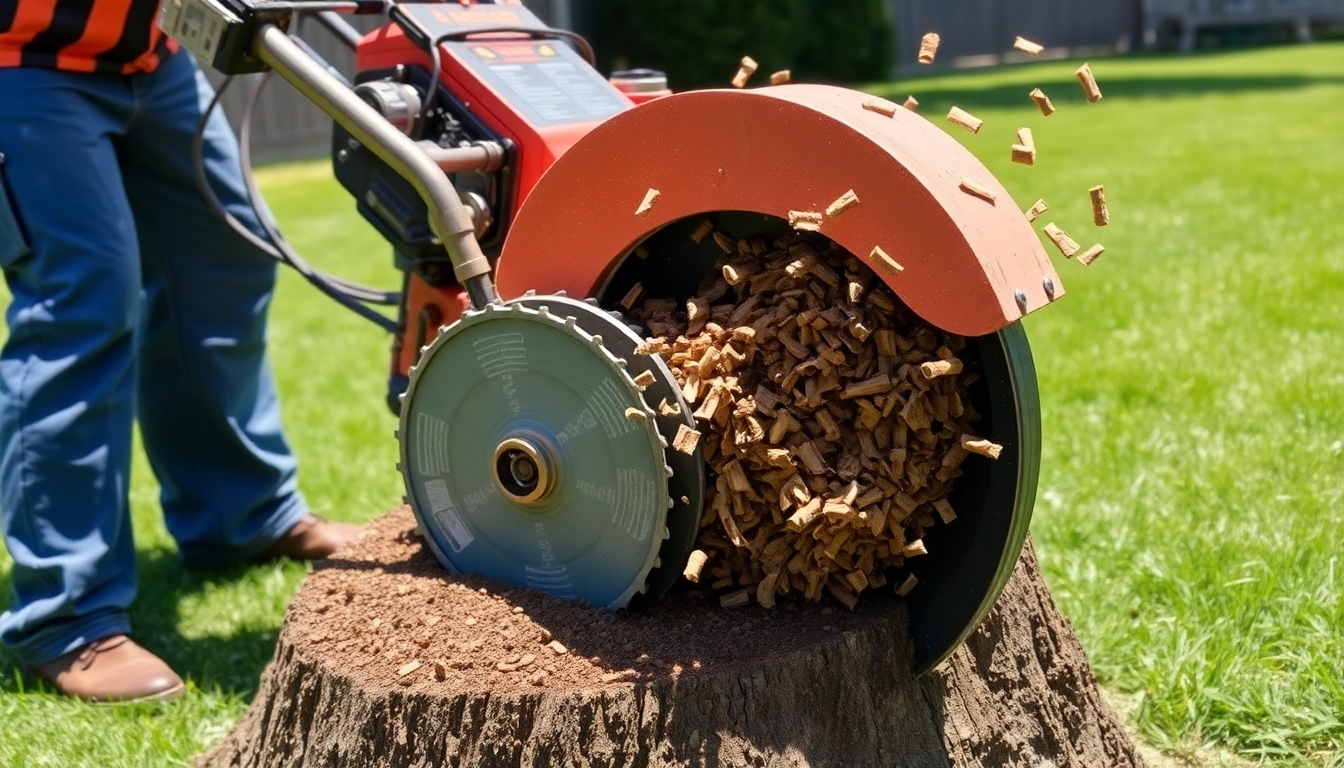Understanding Stump Grinding Services
What is Stump Grinding?
Stump grinding is a professional process for removing tree stumps from your property. Unlike tree removal, which takes the entire tree down to ground level, stump grinding focuses solely on the remnants left behind after a tree is felled. Specialized machinery, known as stump grinders, are used to grind the stump into small wood chips, effectively eradicating it from your landscape. The process leaves behind a hole that can later be filled with soil or other organic material to restore the ground’s appearance and usability. This service is essential for maintaining a clean and safe environment in your yard, especially for homeowners looking to replant or create usable outdoor spaces.
Benefits of Choosing Stump Grinding Services
Opting for a stump grinding service presents numerous advantages:
- Aesthetic Improvement: Stump grinding enhances the visual aspect of your landscape by removing unattractive stumps that can become a focal point of neglect.
- Increased Usable Space: Once the stump is eliminated, the area can be used for new landscaping projects, play areas for children, or simply to create more open space.
- Prevention of Pests: Stumps can attract pests such as termites and beetles. By grinding the stump, you minimize the risk of these unwanted guests in your yard.
- Safety: Stumps pose tripping hazards and may obstruct lawn maintenance. Removing them can significantly improve safety for family members and guests.
- Faster Ground Restoration: Stump grinding is a quicker process than full stump removal and typically does not disturb the surrounding soil as much.
Common Situations Requiring Stump Grinding
There are several scenarios in which stump grinding becomes necessary:
- After Tree Removal: When a tree is cut down, a stump naturally remains. Grinding becomes essential for homeowners looking to repurpose that area.
- Dead or Diseased Trees: If a tree has died or is diseased, it poses a risk to nearby vegetation and structures. Grinding the stump helps prevent the spread of disease.
- Property Development: For properties being developed for new construction or landscaping, stumps need to be ground down to lay a strong foundation.
- Play Areas: If stumps are in or near play areas, removing them is crucial for safety and accessibility.
How Stump Grinding Works
The Stump Grinding Process Explained
The process of stump grinding begins with an assessment of the site. The stump grinder operator evaluates the size of the stump, its location, and the surrounding environment. Once the area is clear and safe to operate, the machinery is brought in to start grinding the stump. The grinder uses a rotating blade to chip away at the wood, grinding it down to a depth chosen based on the homeowner’s needs—typically 4 to 12 inches below ground level. Once ground, the wood chips can be used as mulch or removed from the site, leaving a pebbled surface ready for further landscaping efforts.
Tools and Equipment Used in Stump Grinding
Stump grinding requires specialized equipment, including:
- Stump Grinder: The primary tool, available in various sizes. Smaller models are used for residential areas, whereas larger machines are suitable for commercial sites.
- Safety Gear: Operators wear protective eyewear, gloves, helmets, and ear protection to guard against flying debris and noise.
- Shovels and Rakes: These tools are used for clearing debris and spreading wood chips after grinding.
- Utility Markers: Used to identify underground utilities and prevent damage during the grinding process.
Safety Measures during Stump Grinding
Ensuring safety during stump grinding is paramount. Key safety measures include:
- Site Assessment: Before commencing work, operators survey the site for hazards, including overhead lines, nearby buildings, and other obstacles.
- Proper Signage: Setting up warning signs and barriers can keep pets and children at a safe distance from the work area.
- Communication: It’s vital that all team members communicate clearly and understand their roles during the grinding process.
- Operator Training: Ensuring that the machine operators are trained and certified in stump grinding vastly improves safety and effectiveness of the service.
Selecting a Stump Grinding Service Provider
Factors to Consider When Hiring
When choosing a stump grinding service, several factors should be taken into account:
- Experience and Reputation: Look for companies with solid industry experience and positive customer reviews. An established service provider will likely be more proficient in the task.
- Insurance and Licensing: Ensure the company is insured and licensed to operate in your area. This protects you from potential liabilities.
- Equipment Quality: Inquire about the type of equipment used. Modern, well-maintained machines make for faster, safer work.
- Customer Service: Consider how the company interacts with potential clients. Good communication and professionalism are key indicators of a reliable service.
Questions to Ask Your Stump Grinding Service
Before hiring a stump grinding service, it’s imperative to ask the right questions:
- What is your experience with stump grinding?
- Do you have insurance, and what does it cover?
- Can you provide references from past clients?
- What type of equipment do you use, and is it in good condition?
- What is the estimated timeframe for the project?
- What are your payment terms and cancellation policies?
Cost Considerations for Stump Grinding
The cost of stump grinding can vary significantly based on several factors:
- Size of the Stump: Larger stumps will naturally cost more to grind than smaller ones due to increased time and effort required.
- Location: Accessibility plays a significant role in pricing, as stumps in challenging locations may demand extra work.
- Volume of Stumps: If multiple stumps require grinding, many companies will offer discounts for bulk work.
- Additional Services: Some companies provide landscaping or cleanup services after grinding, which could affect the overall price.
Tips for Preparing Your Property for Stump Grinding
Assessing the Area Around the Stump
Before the stump grinding begins, it’s essential to assess the area surrounding the stump:
- Ensure there is adequate space for the stump grinder to operate without obstructions.
- Check for nearby structures, sidewalks, and utility lines that could be compromised during the grinding process.
- Clear the area of any debris such as rocks or branches that might interfere with the equipment.
Marking Utilities Before Service
It’s crucial to mark any underground utilities prior to commencing stump grinding. Contact a local utility marking service to avoid costly and hazardous damages to pipelines, internet cables, or electrical lines. This safety precaution is not just prudent; it’s often required by law before any excavation or grinding work.
Homeowner Responsibilities during Stump Grinding
As a homeowner, you have several responsibilities to ensure the stump grinding process goes smoothly:
- Provide clear access to the area where the grinder will operate.
- Inform the service provider of any potential hazards or concerns observed on the property.
- Be present during the grinding process to communicate effectively with the service provider.
Post-Stump Grinding Care and Maintenance
Repairing the Ground After Stump Grinding
Once the stump is ground, the resulting hole often needs attention:
- Fill the hole with a mix of soil and compost to facilitate growth if you plan to plant a new tree or flower.
- Level the ground to match the surrounding area to prevent water accumulation.
- Monitor the area for any settling over time, making adjustments as necessary.
Planting in Areas of Recent Stump Grinding
Following stump grinding, many homeowners wish to plant new vegetation. It’s best to wait a few weeks to assess how the area settles, but once ready, consider the following:
- Choose plants suited for the soil condition—a mix of existing ground soil and the wood chips from the stump can affect pH levels.
- Ensure plants have adequate space to grow without interference, as leftover roots can still impact new growth.
- Consider planting native species that require less maintenance and better adapt to your local conditions.
Long-term Landscape Management After Stump Grinding
The removal of a stump can create new opportunities within your landscape. Long-term landscape management may include:
- Regular maintenance of the area, monitoring for signs of remaining roots that could interrupt new plants.
- Incorporating the space into your overall landscape design, considering both the aesthetic and functional elements that can enhance your property.
- Soil health management through fertilization and mulching practices to ensure long-term growth for any new plants.


